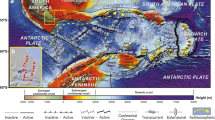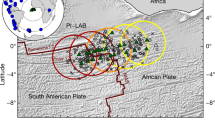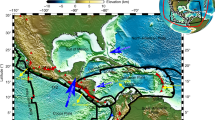Abstract
Melt generated by mantle upwelling is fundamental to the production of new oceanic crust at mid-ocean ridges, yet the forces controlling this process are debated1,2. Passive-flow models predict symmetric upwelling due to viscous drag from the diverging tectonic plates, but have been challenged by geophysical observations of asymmetric upwelling3,4,5 that suggest anomalous mantle pressure and temperature gradients2,6,7, and by observations of concentrated upwelling centres8 consistent with active models where buoyancy forces give rise to focused convective flow2. Here we use sea-floor magnetotelluric soundings at the fast-spreading northern East Pacific Rise to image mantle electrical structure to a depth of about 160 kilometres. Our data reveal a symmetric, high-conductivity region at depths of 20–90 kilometres that is consistent with partial melting of passively upwelling mantle9,10,11. The triangular region of conductive partial melt matches passive-flow predictions, suggesting that melt focusing to the ridge occurs in the porous melting region rather than along the shallower base of the thermal lithosphere. A deeper conductor observed east of the ridge at a depth of more than 100 kilometres is explained by asymmetric upwelling due to viscous coupling across two nearby transform faults. Significant electrical anisotropy occurs only in the shallowest mantle east of the ridge axis, where high vertical conductivity at depths of 10–20 kilometres indicates localized porous conduits. This suggests that a coincident seismic-velocity anomaly12 is evidence of shallow magma transport channels13,14 rather than deeper off-axis upwelling. We interpret the mantle electrical structure as evidence that plate-driven passive upwelling dominates this ridge segment, with dynamic forces being negligible.
This is a preview of subscription content, access via your institution
Access options
Subscribe to this journal
Receive 51 print issues and online access
$199.00 per year
only $3.90 per issue
Buy this article
- Purchase on Springer Link
- Instant access to full article PDF
Prices may be subject to local taxes which are calculated during checkout



Similar content being viewed by others
References
Forsyth, D. W. et al. Imaging the deep seismic structure beneath a mid-ocean ridge; the MELT experiment. Science 280, 1221–1224 (1998)
Katz, R. F. Porosity-driven convection and asymmetry beneath mid-ocean ridges. Geochem. Geophys. Geosyst. 11, Q0AC07 (2010)
Hammond, W. C. & Toomey, D. R. Seismic velocity anisotropy and heterogeneity beneath the Mantle Electromagnetic and Tomography Experiment (MELT) region of the East Pacific Rise from analysis of P and S body waves. J. Geophys. Res.. 108, 2176, http://dx.doi.org/10.1029/2002JB001789 (2003)
Dunn, R. A. & Forsyth, D. W. Imaging the transition between the region of mantle melt generation and the crustal magma chamber beneath the southern East Pacific Rise with short-period Love waves. J. Geophys. Res.. 108, 2352, http://dx.doi.org/10.1029/2002JB002217 (2003)
Baba, K., Chave, A. D., Evans, R. L., Hirth, G. & Mackie, R. L. Mantle dynamics beneath the East Pacific Rise at 17°S: insights from the Mantle Electromagnetic and Tomography (MELT) experiment. J. Geophys. Res.. 111, B02101, http://dx.doi.org/10.1029/2004JB003598 (2006)
Conder, J. A., Forsyth, D. W. & Parmentier, E. M. Asthenospheric flow and asymmetry of the East Pacific Rise, MELT area. J. Geophys. Res.. 107, 2344, http://dx.doi.org/10.1029/2001JB000807 (2002)
Toomey, D. R. et al. Asymmetric mantle dynamics in the MELT region of the East Pacific Rise. Earth Planet. Sci. Lett. 200, 287–295 (2002)
Wang, Y., Forsyth, D. W. & Savage, B. Convective upwelling in the mantle beneath the Gulf of California. Nature 462, 499–501 (2009)
Hirschmann, M. M., Tenner, T., Aubaud, C. & Withers, A. C. Dehydration melting of nominally anhydrous mantle: the primacy of partitioning. Phys. Earth Planet. Inter. 176, 54–68 (2009)
Ni, H., Keppler, H. & Behrens, H. Electrical conductivity of hydrous basaltic melts: implications for partial melting in the upper mantle. Contrib. Mineral. Petrol. 162, 637–650 (2011)
Yoshino, T., McIsaac, E., Laumonier, M. & Katsura, T. Electrical conductivity of partial molten carbonate peridotite. Phys. Earth Planet. Inter. 194–195, 1–9 (2012)
Toomey, D. R., Jousselin, D., Dunn, R. A., Wilcock, W. S. D. & Detrick, R. S. Skew of mantle upwelling beneath the East Pacific Rise governs segmentation. Nature 446, 409–414 (2007)
Katz, R. F. & Weatherley, S. M. Consequences of mantle heterogeneity for melt extraction at mid-ocean ridges. Earth Planet. Sci Lett. 335–336, 226–237 (2012)
Aharonov, E., Whitehead, J. A., Kelemen, P. B. & Spiegelman, M. Channeling instability of upwelling melt in the mantle. J. Geophys. Res. 100 (B10). 20433–20450 (1995)
Key, K. & Constable, S. Broadband marine MT exploration of the East Pacific Rise at 9°50'N. Geophys. Res. Lett.. 29, 2054, http://dx.doi.org/10.1029/2002GL016035 (2002)
Gripp, A. E. & Gordon, R. G. Young tracks of hotspots and current plate velocities. Geophys. J. Int. 150, 321–361 (2002)
Haymon, R. M. et al. Volcanic eruption of the mid-ocean ridge along the East Pacific Rise crest at 9°45–52'N: direct submersible observations of seafloor phenomena associated with an eruption event in April 1991. Earth Planet. Sci. Lett. 119, 85–101 (1993)
Baker, E. T. et al. Hydrothermal plumes along the East Pacific Rise, 8°40′ to 11°50′N: plume distribution and relationship to the apparent magmatic budget. Earth Planet. Sci. Lett. 128, 1–17 (1994)
Kent, G. M., Harding, A. J. & Orcutt, J. A. Distribution of magma beneath the East Pacific Rise between the Clipperton Transform and the 9°17′N Deval from forward modeling of common depth point data. J. Geophys. Res. B 98, 13945–13969 (1993)
Tolstoy, M. et al. A seafloor spreading event captured by seismometers. Science 314, 1920–1922 (2006)
Danyushevsky, L. V., Eggins, S. M., Falloon, T. J. & Christie, D. M. H2O abundance in depleted to moderately enriched mid-ocean ridge magmas; part I: incompatible behaviour, implications for mantle storage, and origin of regional variations. J. Petrol. 41, 1329–1364 (2000)
Saal, A. E., Hauri, E. H., Langmuir, C. H. & Perfit, M. R. Vapour undersaturation in primitive mid-ocean-ridge basalt and the volatile content of Earth’s upper mantle. Nature 419, 451–455 (2002)
Hirose, K. Partial melt compositions of carbonated peridotite at 3 GPa and role of CO2 in alkali-basalt magma generation. Geophys. Res. Lett. 24, 2837–2840 (1997)
Wendlandt, R. F. & Mysen, B. O. Melting phase relations of natural peridotite + CO2 as a function of degree of partial melting at 15 and 30 kbar. Am. Mineral. 65, 37–44 (1980)
Dasgupta, R., Hirschmann, M. M. & Smith, N. D. Water follows carbon: CO2 incites deep silicate melting and dehydration beneath mid-ocean ridges. Geology 35, 135–138 (2007)
Minarik, W. G. Complications to carbonate melt mobility due to the presence of an immiscible silicate melt. J. Petrol. 39, 1965–1973 (1998)
Constable, S. SEO3: A new model of olivine electrical conductivity. Geophys. J. Int. 166, 435–437 (2006)
Egbert, G. D. Robust multiple-station magnetotelluric data processing. Geophys. J. Int. 130, 475–496 (1997)
Key, K. & Ovall, J. A parallel goal-oriented adaptive finite element method for 2.5-D electromagnetic modelling. Geophys. J. Int. 186, 137–154 (2011)
Constable, S. C., Parker, R. L. & Constable, C. G. Occam’s inversion — a practical algorithm for generating smooth models from electromagnetic sounding data. Geophysics 52, 289–300 (1987)
Berdichevsky, M. & Dmitriev, V. I. Models and Methods of Magnetotellurics (Springer, 2008)
Wannamaker, P. E., Hohmann, G. W. & Ward, S. H. Magnetotelluric responses of three-dimensional bodies in layered earths. Geophysics 49, 1517–1533 (1984)
Zhong, S., Zuber, M. T., Moresi, L. & Gurnis, M. Role of temperature-dependent viscosity and surface plates in spherical shell models of mantle convection. J. Geophys. Res. 105, 11063–11082 (2000)
Acknowledgements
We thank the captain and crew of R/V Roger Revelle, members of the scientific party (J. Behrens, G. Boran, G. Heinson, J. King, A. Massarweh, L. Terzi and C. Weiss), and the technical team (C. Armerding, P. Cheng, C. Berger, G. Englehorn, G. Howe, K. Callaway and J. Lemire). We thank D. Myer for assistance with the data processing and R. Katz for reviewing the manuscript. This work was funded by US NSF award OCE-0241597 and the Seafloor Electromagnetic Methods Consortium at Scripps Institution of Oceanography.
Author information
Authors and Affiliations
Contributions
K.K. and S.C. collected and analysed the field data. A.P. and K.K. performed the melt calculations. L.L. carried out the mantle flow simulations. K.K. wrote most of the manuscript. All authors discussed the results and commented on the manuscript.
Corresponding author
Ethics declarations
Competing interests
The authors declare no competing financial interests.
Supplementary information
Supplementary Figures
This file contains Supplementary Figures 1-8. (PDF 5517 kb)
Rights and permissions
About this article
Cite this article
Key, K., Constable, S., Liu, L. et al. Electrical image of passive mantle upwelling beneath the northern East Pacific Rise. Nature 495, 499–502 (2013). https://doi.org/10.1038/nature11932
Received:
Accepted:
Published:
Issue Date:
DOI: https://doi.org/10.1038/nature11932
This article is cited by
-
Mantle heterogeneity caused by trapped water in the Southwest Basin of the South China Sea
Nature Communications (2023)
-
Low-noise, low-power-consumption seafloor vector magnetometer
Journal of Oceanology and Limnology (2023)
-
Vertical depletion of ophiolitic mantle reflects melt focusing and interaction in sub-spreading-center asthenosphere
Nature Communications (2022)
-
Spreading-rate dependence of hydroacoustic and teleseismic seismicity of ridge-transform systems: East Pacific Rise, Galapagos Ridge, and Mid-Atlantic Ridge
Acta Oceanologica Sinica (2022)
-
What can we learn from REE abundances in clinopyroxene and orthopyroxene in residual mantle peridotites?
Contributions to Mineralogy and Petrology (2021)
Comments
By submitting a comment you agree to abide by our Terms and Community Guidelines. If you find something abusive or that does not comply with our terms or guidelines please flag it as inappropriate.



